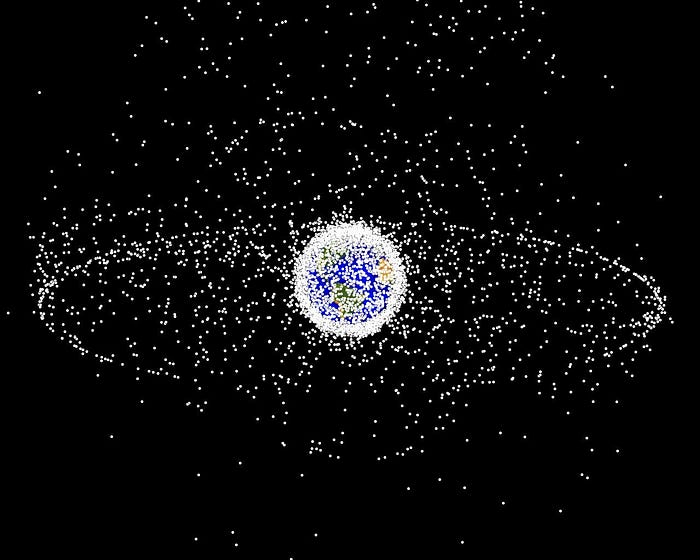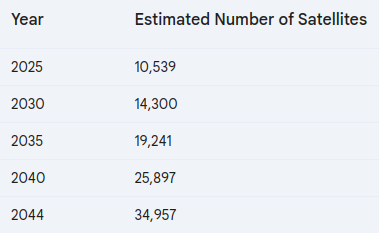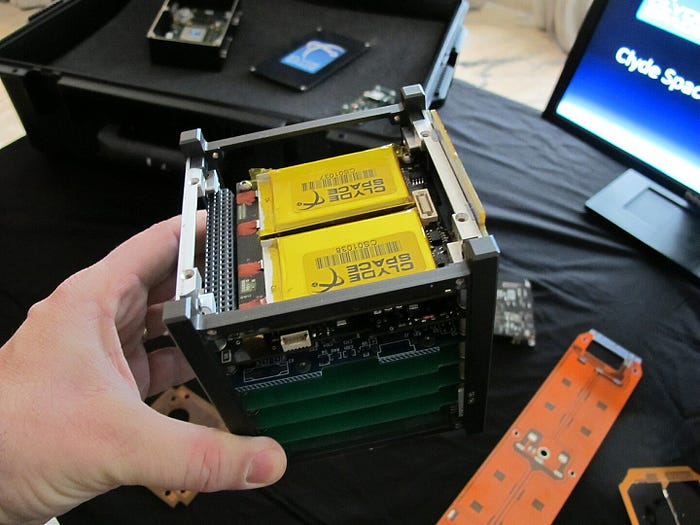On June 26th, 2024, Resurs-P1, a defunct Russian remote sensing satellite, unexpectedly fragmented into hundreds of pieces — colloquially known as an unscheduled disassembly. This breakup forced astronauts aboard the International Space Station (ISS) to take shelter as a precaution against potential collisions with the newly created debris field.
[The event occurred] at an approximately 350 x 363 km Low Earth orbit according to debris-tracking service LeoLabs. United States Space Command later confirmed that Resurs-P1 had broken up into over 100 pieces of trackable space debris at approximately 16:00 UTC on 26 June 2024; LeoLabs later that afternoon announced that it was tracking 180 pieces of debris. Although there was no immediate threat to other satellites, because this orbit was close to that of the International Space Station its crew took shelter on the docked spacecraft for an hour as a precautionary measure.
This breakup likely happen because the satellite's passivation was not performed properly or performed at all. The use of an anti-satellite weapon is not in question since nothing of the sort was detected by any American or European assets. (Wikipedia)
The cause of the incident remains under investigation.
How did it happen?
While the official pronouncements haven't revealed a definitive reason, space debris analysis companies like LeoLabs believe a "low-intensity explosion" could be the culprit. This explosion, they theorise, could have originated from two sources:
- External Impact: A collision with an uncatalogued piece of space junk, too small to be previously tracked, might have triggered the breakup. Space debris is a growing concern, with thousands of defunct satellites and fragments whizzing around Earth at high speeds. Even a minor collision with such an object could cause catastrophic damage to a satellite.
- Internal Malfunction: An internal failure within Resurs-P1 itself is another possibility. A malfunction in its propulsion system or a battery rupture could have created enough internal pressure to cause the satellite to break apart.
The exact nature of the explosion may never be known, as Resurs-P1 was already out of service. However, the incident highlights the dangers of a cluttered orbital environment. The debris field created by the breakup is estimated to contain at least 250 trackable fragments, potentially posing a threat to operational satellites and future space missions.
There is no public information available to confirm whether Resurs-P1 had a nuclear power source on board, but it is unlikely.
Previous events
This event comes just three years after a controversial anti-satellite (ASAT) missile test conducted by Russia. In that instance, they deliberately destroyed a defunct satellite, creating a massive debris field that was widely condemned by the international community. While the cause of the Resurs-P1 breakup appears accidental, it raises concerns about the potential for further militarisation of space.
The international space community is actively tracking the debris from Resurs-P1. Organisations like the U.S. Space Command and private companies such as LeoLabs specialising in space situational awareness are monitoring the debris cloud to assess potential collision risks with operational spacecraft. Initial assessments suggest the debris poses no immediate threat to the ISS or other critical satellites.
Long term implications
However, the long-term implications are important. The debris will remain in orbit for years, potentially creating a hazard for future space missions. This incident emphasises the urgent need for international collaboration to develop strategies for mitigating space debris. Potential solutions include debris removal missions, improved satellite design to avoid future breakups, and international space traffic management regulations.
The breakup of Resurs-P1 serves as a reminder of the growing vulnerability of our space infrastructure.
What to do with defunct satellites
There isn't a single, comprehensive international agreement solely focused on old satellite disposal. However, there are existing space treaties and guidelines that touch upon this issue:
The Outer Space Treaty (1967)
This foundational treaty forms the basis of international space law. While it doesn't directly address disposal, it establishes that countries bear international responsibility for their space activities and "shall avoid their harmful contamination and also adverse changes in the environment of outer space." This can be interpreted to include minimizing debris from defunct satellites.
The United Nations Space Debris Mitigation Guidelines:
These non-binding guidelines, adopted by the UN in 2007, outline best practices for minimizing space debris. They recommend post-mission disposal strategies for satellites in Low-Earth Orbit (LEO) like Resurs-P1. Ideally, these satellites should be maneuvered into a graveyard orbit — a higher orbit where they pose less risk of collision with operational spacecraft.
The current situation highlights the limitations of these existing frameworks. The guidelines are not mandatory, and enforcement mechanisms are weak. This is a major concern as superpowers are testing military anti-satellite technologies ranging from ground-based lasers to anti-satellite satellites.
Space debris removal
Satellite debris removal systems, also known as Active Debris Removal (ADR) systems, are a relatively new concept. The growing threat of space debris has spurred significant research and development efforts.
The growing problem
There are currently thousands of defunct satellites and millions of pieces of debris orbiting Earth. Collisions with even small debris can be catastrophic for operational spacecraft due to the high relative speeds in orbit. The Kessler Syndrome is a hypothetical scenario where collisions create even more debris, leading to an exponential growth of debris and rendering space unusable.

Debris growth forecast
As of May 4th, 2024, there are estimates that around 9,900 active satellites are currently orbiting Earth (Kongsberg/nanoavionics.com). This number is constantly changing due to new launches and decommissioned satellites re-entering Earth's atmosphere.
Here's a forecast of the expected growth in the number of satellites over the next 20 years, based on a conservative estimate of a 6% annual growth rate (averaged from several sources):

This is just an estimate. The actual growth rate could be higher due to factors like the increasing demand for satellite internet constellations such as Starlink and OneWeb, arise in miniaturisation technologies allowing for the launch of constellations of smaller satellites such as Cubesats.

The development of reusable launch vehicles making launches more affordable will only compound the problem. Elon Musk's SpaceX launch platforms release as many as 60 satellites in one mission.

Current Stage of Development
Several ADR concepts are being explored, each with its own advantages and limitations.
Nets and Harpoons: These systems capture debris objects with nets or harpoons and deorbit them together through a controlled re-entry into Earth's atmosphere.
Deorbiting Satellites: Attaching a propulsion module to a defunct satellite and maneuvering it to a lower orbit for faster natural decay.
Non-contact Techniques: Using lasers or other directed energy beams to nudge debris objects into a lower orbit.
Challenges
Developing and deploying these systems in space requires significant technological advancements. And cost. as always, is an issue. Effective debris removal will require considerable collaboration between nations to share data, resources, and expertise — and technology, which is likely to be a major stumbling block.
Current projects
RemoveDEBRIS: A European Space Agency (ESA) project that successfully tested a satellite equipped with a net and harpoon system for debris capture.
ClearSpace-One: A Swiss startup developing a mission to remove a defunct satellite from orbit using a robotic arm.
NASA's Adrift De-orbiting Rocket Extension (ADRE): A conceptual design for a low-cost de-orbiting module to be attached to spent rockets.
In conclusion
There's a lot of junk up there, and it's not going away anytime soon. The explosion of Resurs-1 was typical of what we can expect— one satellite becomes 250+ pieces.
Something really effective will need to be done soon, or future space missions will be grounded.
Update
(July 11, 2024) Japan has just demonstrated autonomous (AI controlled) collision avoidance ability in one of its spacecraft.
Astroscale Japan has shown off images of orbital debris and demonstrated the ability of its spacecraft to avoid adding to the problem thanks to an autonomous collision avoidance system.
The ADRAS-J spacecraft was launched on a Rocket Lab Electron in February — a mission dubbed "On Closer Inspection" — to investigate a derelict HII-A upper stage.
The spacecraft came within several hundred meters of the 11-meter upper-stage rocket body in April and was within 50 meters by the end of May. On June 19, the fly-around operation began while maintaining a fixed distance of 50 meters, the company said today.
The purpose of the fly-around was to demonstrate the capabilities of the technology used for the ADRAS-J spacecraft and capture images of the derelict stage, which weighs approximately three tons.
However, a third of the way through the fly-around, an autonomous abort was triggered "due to an unexpected attitude anomaly," and ADRAS-J backed away from the spent stage.
While unplanned, the automatic abort was a useful demonstration of ADRAS-J's ability to avoid collisions and, therefore, not become part of the debris problem itself that it is trying to help clear up. — TheRegister
That may be clever, but much of the debris is not the size of an 11 metre long upper stage. And every manouevre uses precious fuel.
Follow me and I guarantee variety in your inbox with some unusual perspectives on technology, space, geopolitics and travel. I also write thrillers on those lines.

My novels are available at my Gumroad bookstore. Also at Amazon and Apple
Or maybe just buy me a coffee? and tell me what you liked reading (or not)…

